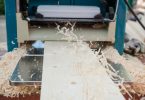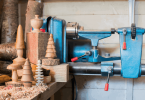Woodworking is not only my hobby. It’s my sanity. No matter what the day throws at me, I always know that when the sun goes down, I can retire to my basement wood shop. The sense of pride and accomplishment woodworking gives me is the icing on the cake of life.
But there is one part of fine woodworking that doesn’t quite thrill me. To get a beautiful finish, sanding is a requirement, a lot of sanding. I spend more time sanding than I do actually building projects (Trust me, I use one of the most powerful belt sanders). You could say, sanding is the one part of woodworking that I happily relegate to machinery.
I have orbital, disc, corner, and some dual-purpose sanding tools. But for the big jobs, I reach for my belt sanders. They really get the job done! But even within this class, there are different types and levels of quality. So, before you buy a belt sander, I am here to help you get educated on what to look for and which ones to consider.
Our Top 10 Picks on Best Belt Sanders
So, with all of that information as background, let’s examine what we believe to be the top 10 models of belt sanders that you should consider. As I said, none of these machines is the perfect solution for every application. But I do believe that each of these machines is appropriate for the particular niche that we place it in. It’s up to you to decide where your needs lie.
01 Tacklife Belt Sander (Our Pick)
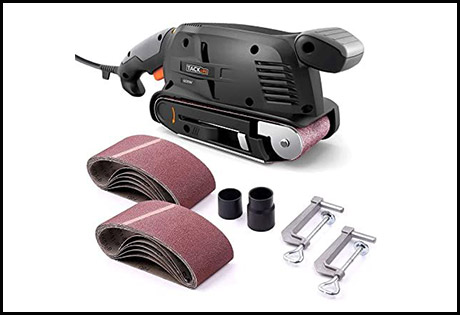
Why We Recommend This Product
I will admit that I didn’t think this machine would end up getting our best handheld belt sander rating. On paper, I wasn’t impressed. Its 5-amp, 600-watt motor didn’t strike me as having enough power. Also, its relatively low price point (around $55 bucks) suggested a entry-level model to me. Wow! Was I wrong!
The Tacklilfe PSFS1A is a great little workhorse! That motor is more than enough to power the 3×18-inch sanding belt at a rate of 14 working feet per second. Too fast? With six speed settings available, you can dial in the exact speed for any sanding task.
Detailed Review
The Tacklife 3×18 sits atop our list because no matter what your task may be, it won’t disappoint. One of the most important elements to being named as hand belt sander is how it fits in your hands. The Tacklife offers great ergonomics with a comfortable rear handgrip and a nicely designed front grip.
Adding to the great feel is the wheel at the top of the rear handle that allows you to select any of six speed settings with a simple flick of the thumb. The power trigger has a lock to also ease the strain during lengthy usages. It is also a more low-slung design than many of the models we reviewed. It simply fits in your hands better.
The Tacklife dust collector is a box that attaches to the side of the machine. The company claims it has a 90% collection rate. You can also remove the box and attach a vacuum hose directly to the dust port with the supplied adaptor.
Here’s another nifty feature. The Tacklife comes with two specially designed C-clamps that let you flip the machine upside down and clamp it to a workbench or other surface. Now, you have a platform sander!
Once note of caution. If you are planning to sand large areas of hardwood floor, you might want to look at other machines. There are other hand-held sanders that are more qualified for that type of work. But as a general-purpose machine, the Tacklife is our choice in the small frame category.
The Tacklife 3×18 has a ten-foot cord and weighs in at 7.7 pounds. On a One-to-Ten scale, online reviewers give it an 8.4 rating.
Pros
- Excellent Ergonomics
- Platform sander option
- 6 speed settings
Cons
- Modest power rating
- Not suited for large jobs
Final Verdict
The Tacklife 3×18 is a great all-around machine in our reviews. The variable speed settings, comfortable ergonomics, and ability to transform into a platform sander make this our top pick for most home usage situations. If your goal is to become a professional hardwood floor refinisher, there are better options out there. But if your needs for a sanding machine are a bit more varied and modest, the Tacklife PSFS1A will be a comfortable fit in your hands.
02 Wen 6502 (The Most Versatile)
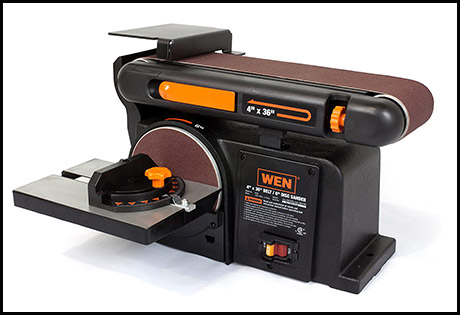
Why We Recommend This Product
Heavy duty sanding requirements call for a heavy-duty machine. Nothing out there fits the bill better than this bench-mountable beast from Wen. The 4×36-inch belt and 6-inch sanding disc are powered by a 4.3-amp motor that churns out a whopping ½ horsepower. That’s authority!
The huge belt can be tilted anywhere from 0° to 90°, and the disc table can be adjusted up to a 45° bevel. Add the gravitas of a cast iron framework, and you have a sanding machine that can meet any challenge with ease.
Detailed Review
Wen is well-known for building top of the line industrial power tools, and the Model 6500 belt and disc sander doesn’t disappoint. Everything about this system screams professional grade. From the half-horsepower motor to the cast iron frame, this 39-pound beast is one of those machines you’ll have for a lifetime.
This bench-mount belt sander has an adjustable table that you can set at any angle. The disc sander on its side also has an adjustable bevel table. As an added bonus, that table can be repositioned to work with the power tool! I do wish the table had a bit more heavy-duty design, though. Given the heft of the rest of this machine, the table seems almost flimsy. The large belt tracking adjustment knob is right out front, so keeping the belt running straight is a piece of cake. Changing the belt is simple, too. The large tension release handle is right next to the tracking knob, so downtime for belt changes is just a matter of seconds.
The disc isn’t quite as easy to work with. Wen has opted to make this a glue-on disc pad design, as opposed to using the hook-and-loop attachment technique that has become popular on many sanding tools. I’m sure the decision was made because glued-on pads work better under heavy loads, but having the option to go the hook-and-loop route would be nice.
That powerful 4.3-amp motor spins the belt at an amazing 1900 feet per minute, while the disc sander spins at 3600 RPM. There is a 2.5-inch dust collection port on the side that can be attached directly to your shop vac. At the rate at which this powerful sander can work, you’re going to want to do that.
The Wen 6500 series sanders come with a two-year warranty and access to Wen’s toll-free customer service line. Online reviews from real world purchasers give this unit a score of 8 out of 10.
Pros
- Heavy duty design
- Adjustable belt angles
- Two-year warranty
Cons
- Flimsy work table
- Glue-on discs
Final Verdict
No wood working shop is complete without a heavy-duty belt sander, and the Wen 6500 steps up to the task with ease. It has a powerful motor, an adjustable table design that allows you to work at almost any angle, and enough mass to keep it from vibrating when you’re working on delicate finishing projects. No wonder why it’s one of the top rated sanders at this price point.
This bench-mount sander is simple enough in design for anyone to master it, yet capable enough to meet any demands. At around only $116 dollars, you’ll still have some jingle left in your pocket to buy a few pieces of wood that need sanding.
03 Skil 7510-01 Sandcat (The Budget King)
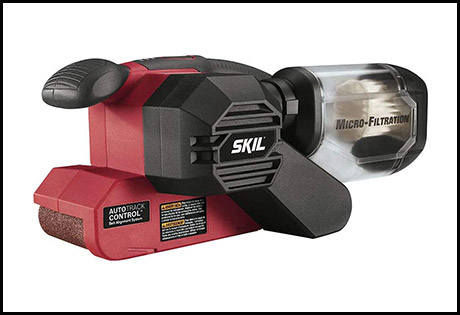
Why We Recommend This Product
Skil is another well-known brand name in the woodworking arena with a reputation for offering high quality equipment. The selection of the Sandcat as our choice in budget belt sander category doesn’t disappoint. For under $40 you can wrap your hands around the comfortable grips of sanding tool that features a couple of great innovations.
Auto-tracking and pressure control are two things you won’t hear about with even the highest rated models on the market. But you get both with this entry from Skil.
Detailed Review
One of the most irritating things about working with many belt sanders is getting the belt to track smoothly without wandering from side to side. But the auto-tracking design built into the Skil Sandcat means you don’t even have to think about that. It is only an 18-inch belt, which means you have a fairly small contact surface. Large jobs are going to take more time.
Belt changes are done with just one lever, and no tracking adjustment to drive you crazy. It also means you can use this belt sander to work right up to the edge of hardwood floors with ease.
Another challenge with using this model is knowing how much pressure you to apply for optimal function. Push too hard and it can dig into the wood and ruin your project, or bog down and fail completely. Don’t apply enough downward pressure, and you’ll never get the work finished.
The “Pressure Control Technology” built into this machine is one of the reasons it gets our vote for the top budget belt sander. There are three lights (green, yellow, red) on the top of the machine that tell you when your pushing too hard. I love it when a machine does the thinking for me!
Dust is an ever-present annoyance when sanding, but the Skil 7510-01 employs a dust catcher with a micro-filtration filter built in. The canister is even made of clear plastic, so you can see when it’s time to empty it. It can also be removed to allow for direct attachment to a vacuum.
The six-foot cord seems a bit stingy, but then again, most applications are going to need an extension cord anyway. Comfy soft grips and a trigger lock make for a nice hand-to-machine interface.
Pros
- Auto-tracking belt
- Pressure control indicators
- Low price
Cons
- Small 18-inch belt
Final Verdict
There are a lot of cutting-edge features on the Skil Sandcat that make it rise above the image of an inexpensive belt sander. But, at around forty bucks, it certainly is one of the cheapest in our top ten. With automatic tracking of the belt and a pressure sensor that tells you how hard to push, this little tool almost does the work for you. But I do emphasize the word little because the 18-inch belt means you are working a smaller area than with a 21-inch version. Still, for small jobs and small budget jobs, the Skil Sandcat can’t be beat.
04 Makita 9903 8.8-Amp ( Great for Advanced Users)
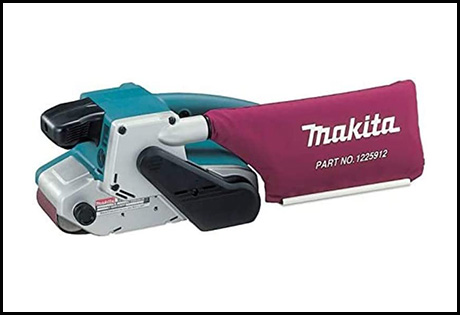
Why We Recommend This Product
Two words: Professional grade. It’s powerful. It’s quiet. It has a lot of advanced features, like an ergonomic handle and a belt that runs right along the right side of the sanding plate, meaning you can sand right up to the edge of the floor with ease. It has a variable speed control so you can match the speed to the sanding task at hand. Another major point in the win column for this entry is the 3×21-inch belt, meaning you have a larger sanding area and can accomplish the job more quickly.
Detailed Review
The strengths of the Makita 9903 begin with its powerful 8.8-amp motor. That’s enough power to sand your way through any task with ease. All of that power is handed down to the 3×21-inch sanding belt by way of a variable speed drive that allows you to adjust the speed of the belt from 690 feet per minute all the way to 1,440 ft/min. That allows you to set the sanding speed to your liking. That large belt gives you a greater surface area for the sanding plate.
Another great feature is that the belt runs flush with the right side of the machine, meaning you can sand a floor right up to the side moulding with ease. Makita says you can also do the same thing with the front nose of this machine; however, I don’t quite agree with them on this point. For one thing, the front roller is a standard size, which means the belt doesn’t make contact with the surface being sanded until about an inch behind the front of the machine. And even then, the sanding plate itself is set even further back. It’s simply not possible to get that close to a wall, for example, with the nose of this sander.
That gripe aside, this is a great sanding machine. With a 16-foot power cord, a hefty 9.5-pound tip of the scale, a one-year warranty, and a dust bag large enough to tackle major tasks without constant emptying, the Makita 9903 is a go-to choice for pros.
One last thing I want to mention. This Makita delivers all of this at a decibel rating of just 84dB. That’s the quietest rating for any of our 3×21 belt sander model reviews. It may not seem like a big deal, but sand an entire living room sometime and see how much noise you have to endure with other machines. You’ll pick this Makita, too.
Pros
- Professional grade
- Variable speed
- Powerful motor
- Flush edge sanding
Cons
- Expensive
- Nose doesn’t sand flush
Final Verdict
You are going to lay out some cash for the Makita 9903 (about $220 worth), but if you are looking for a machine capable of tackling anything you can expect of a belt sander, this is the one. Good power, variable speed, auto-tracking 21-inch belt, flush right-side sanding, a quiet noise level, and comfortable handles all translate into one of the finest models you can buy. If you are looking for a sanding machine that can stand up to the toughest jobs, you just found it.
Online reviewers echo that sentiment. More than 250 reviewers give it a 9.2 out of 10 rating, with 84% of them giving it a straight 10. That’s a ringing endorsement.
05 Makita 9403 4×24-Inch (Choice for Professionals)
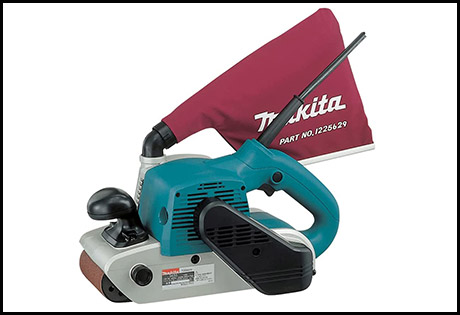
Why We Recommend This Product
I know what you’re thinking. “Didn’t you just say the Makita 9903 was the best?” Well, yes, I did. But I was talking about 3-inch wide belt sanders. The 9403 is, in many respects, the big brother of that machine. It is essentially the same great design but with a more powerful motor, heavier weight, and a 4-inch wide belt instead of three inches.
That’s a 25% wider sanding path with every pass you make. On a large hardwood floor, that could save you a couple hours of work. Not a bad deal. So, if you do a lot of big jobs, I definitely recommend a 4-inch sanding tool.
Detailed Review
With a 4-inch wide belt that runs at up to 1,640 ft/min, you know this bad boy is going to make quick work of big sanding jobs. This is a serious machine really designed for hardwood floor refinishing and other major work. It’s not the sander you want to use for highly detailed work on tiny wooden figurines. But when the job calls for a big gun, this is it.
An 11-amp motor powers the 4×24-inch belt with ease. It has a variable speed setting that is coupled with electronic speed control to maintain a consistent sanding rate regardless of the load. The belt rides on a ceramic wear plate that is designed so the machine can sand a hardwood floor right up to the walls with no gap. And if you manage to use it enough to wear that ceramic plate down, it’s even replaceable.
This is the kind of sanding machine designed for all-day operation like a hand planer. But running a sanding machine all day is a physically demanding task for any operator. Makita tries very hard to make the job as comfortable as possible with a large, actually comfortable, upfront hand grip. Also, the ultra-quiet operation noise of 84dB is among the quietest sanders you’ll find at any price.
Speaking of price, yes, the Makita 9403 is going to sand your wallet down to the tune of over $400 (I have seen it on sale for under 300 bucks), but this machine is really designed to help you make good money in the long run. Investing in great tools is never wasted money, and this Makita certainly is great.
But don’t just take my word for it. 270 online reviews from actual owners give this machine an 8.6 out of 10, and 79% of them gave it a 10.
Pros
- 4-inch belt
- 11-amp motor
- Great ergonomics
Cons
- Expensive
- Weak dust bag mount
Final Verdict
The Makita 9403 is a bad ass in the world of belt sanders. It is heavy (at 16 pounds), which helps complete jobs faster but also can contribute to operator fatigue. But Makita compensates for that with comfortable handles and a very low noise level. Above all, this is a powerful machine with a big belt that can dispatch large jobs without fail.
If you are only looking for an inexpensive belt sander for puttering around in your home shop, this one is overkill. But if you see sanding hardwood floors or outdoor decks in your near future, yeah, pick this guy. After performing the initial task with a belt sander, involve a random orbital sander to get a smoother finish.
06 Black & Decker ds321 Dragster 7-Amp (Great for Handling)

Why We Recommend This Product
The first thing you notice about this belt sander from Black & Decker is that the front roller is much smaller than the standard-sized rear roller. It’s obvious that it draws the name from the Top Fuel dragsters designed with small front wheels and massive rear slicks.
Just like those dragsters, there’s a reason Black & Decker chose this design. That tiny front roller allows you to work closer to the wall when sanding floors, or any other corner that you might run into in your wood working projects. The unit also features a flip-up hood on the front end so you can actually use the top side surface of the belt for hard-to-reach spots.
Detailed Review
Part-gimmick and part useful innovation is how I view the small front roller on the Dragster. Yes, it does allow you to utilize this portable model in some places you wouldn’t normally be able to get a belt sander. The smaller roller also allows for a longer pressure plate on the bottom side, which does actually help you sand closer to walls and corners. It also gives the tool a larger work patch in general.
But the small roller doesn’t really solve the problem that you are trying to get a round roller into a square corner. In truth, it doesn’t fit and never will. So, take this design with just a grain of salt.
The flip-up lid over the front topside of the roller is actually a more useful feature. It allows you to sand in places you would never think of getting a belt sander, between stair or deck railings, for example. To accommodate this feature, Black & Decker adds another one; a 3-position front handle. It’s nice to be able to adjust that grip, but be aware that to use the topside sanding function, the front handle must be in the full upright position.
Most of the machines on our top-10 list have variable speed controls. The lack of this feature on the Dragster is a glaring omission, even for an inexpensive unit.
This 6-amp sander is a bit of a lightweight, especially compared to some of the beefier models we are listing here, but the ability to get places other sander models can’t does fill a niche in the market. At around 50 bucks, it’s not a big investment, either.
Pros
- Able to get into tight spots
- Flip-up cover for topside sanding
- Longer than average sanding plate
Cons
- Low power rating
- Single speed
Final Verdict
If I had big sanding jobs, or I was looking for a one-size-fits-all belt sander, this wouldn’t be my choice. But if I planned to own several sanding machines (I currently have 3 so, hey, it happens) and I was looking for one that specialized in getting into tight spaces where other models don’t dare to go, this machine would be a good choice.
The features that really standout on this machine just might make it the right choice for a hobbyist who routinely needs to sand in tight spots or small areas. If that’s you, take a close look at the Dragster from Black & Decker.
07 Wen 6321 7-Amp (Our Compact Choice)
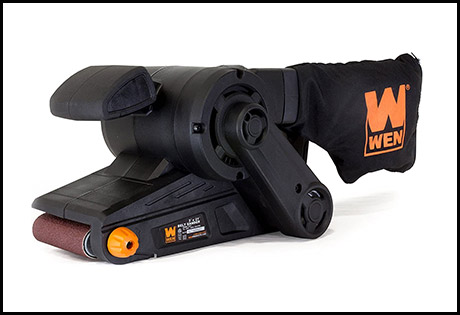
Why We Recommend This Product
For starters, at just six pounds, the Wen 6321 is certainly compact. It fits small hands and does small sanding tasks just as well as any other belt sander out there, making it a perfect choice for the compact title.
One place where it acts like a bigger unit is the belt size. I figured our compact choice would likely use an 18-inch belt, but this one manages to use both a 21-inch belt and still stay compact. That larger belt size has two distinct advantages. There is 15% more sanding area on each belt, which translates to a longer life. Secondly, the sander itself has a longer sanding plate on the bottom which is far more efficient.
Detailed Review
The slightly smaller than normal front roller on the Wen 6321 actually has a bit of an overbite. That is to say, it extends beyond the framework of the sander. You can tip the machine forward, ever so slightly, and sand right up to the corner, so much closer than any other machine. That is my favorite feature of this particular model.
Aside from this one handy feature, this model is fairly standard. It has a reasonably powerful 7-amp motor and a fairly standard dust bag design. It is not a variable speed machine, meaning the belt spins at only one speed, which happens to be 820 feet per second. It doesn’t have an auto-tracking design, although keeping the belt tracking adjusted is fairly easy with an adjustment knob right on the side of the front roller.
Two other positive factors to point out. First, it can be secured upside down in order to use it as a platform sander. And secondly, it comes with a two-year warranty from Wen, which is the longest of any unit in our top ten list. Wen has a very good reputation for building quality machinery, so the odds of needing that warranty are actually quite low.
In all, it’s certainly not the most capable belt sander in our survey, however at less than $40, you are going to be hard-pressed to find anything better.
Pros
- Extended front roller
- 2-year warranty
- Low price
Cons
- Single speed
- No auto-tracking
Final Verdict
You are not going to sand your way through the trunk of a redwood tree with this machine, but for a forty-dollar machine, it’s pretty darn good. The under-sized and extended front roller lets you sand where machines with large front rollers can’t even think about going. The 7-amp motor isn’t a major powerhouse, but it’s enough to handle the types of jobs for which this belt sander was destined. The lack of variable speed settings is disappointing, but then again, you don’t reach the stars for forty bucks. If budget is a concern and the tasks aren’t too demanding, this is a great model with two years warranty. In that case, I say go for it.
08 Hitachi SB8V2 9.0-Amp
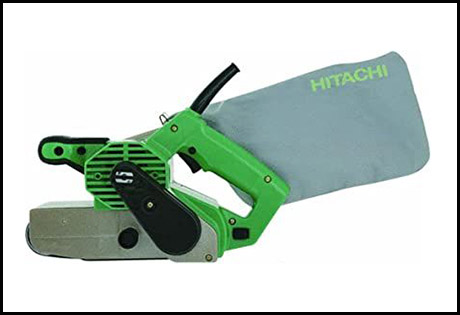
The 9-amp motor gives this portable belt sander from Hitachi a lot of capability. That significant power is harnessed through a variable speed adjustment that can run the sanding belt anywhere from 820 ft/min up to 1475 ft/min. Elastomer-coated grips mean this machine can be easy on your hands in all day usage. A clear plastic window on the top front of the machine allows you to watch the tracking of the sanding belt with ease. And a v-belt design means the power is transferred from the motor to the drive train assuredly, and nearly eliminates the possibility of a belt failure.
Owners of this machine have reported some curious concerns. The one that bothers me most is the reports that it isn’t very well balanced. The machine seems to be a bit heavier on the left side than on the right. That may not sound like a big deal, but if you are trying to sand, say a tabletop, nice and smooth and level, a small matter like an imbalance in the machine can make things go off-kilter in a bad way.
The other issue that disturbs me is persistent reports of static-shock build-up. The act of sanding creates static electricity, which normally dissipates at unnoticeable levels through the operator’s hands. However, the elastomer on this machine creates an insulating layer, so the static builds up and the Zaps the operator!
However, this is still a very good belt sander – good enough to make our top ten list. It is worth a look, and you just might find it fits the bill for your needs.
Pros
- V-belt drive
- 9-amp motor
Cons
- Left-right imbalance of machine
- Static electricity discharges
Final Verdict
There is a lot of power in the 9-amp motor of this machine. Delivered through a variable speed control and a v-belt drive, that power means you can get a lot of work done with this machine. But the reports of a weight imbalance and static shock discharges make us wonder if this is the right machine to lay down as much as $286 on.
If you wear leather gloves while you work, the discharge issue is a non-factor. If you are skilled with a belt sander the imbalance is also not significant, and you will certainly get a lot of work done with this powerful unit. But if you are a novice with a piece of equipment like this, there may be better choices.
09 Genesis GSB321A Variable Speed
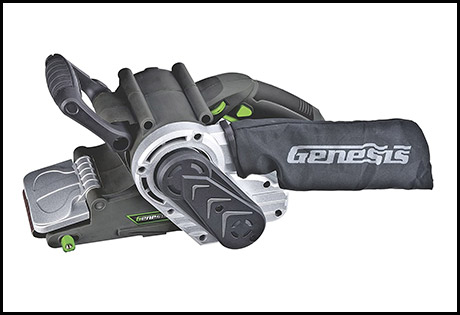
This belt sander combines many of the features I have talked about in previous reviews. It has a small front roller, a flip-up cover on the topside for sanding in close quarters, and adjustable front handle, and flush side sanding capabilities on the right side. It also sports a variable speed control.
Combine all of that with an 8-amp motor and an auto-tracking belt system, and you have a 3×21-inch sanding machine that is certainly worth taking a look at. Still not convinced? Genesis throws in a 2-year warranty on top of all those features.
Online reviews for this machine are tepid. On the one-to-ten scale it only ranks 7.6, and half of reviewers were less than thrilled. Many of the complaints revolve around plastic parts breaking, variable speed switch failures, and other catastrophic occurrences.
Still, have of the real-world owners did give the machine a 10, so Genesis must be doing something right. This machine sells in the $50 range, and the old saying “You get what you pay for” seems to apply. If you are willing to roll the Fifty on it, you just might find yourself one of the 50% who hit the jackpot with this belt sander.
Pros
- Many high-end features
- Low price point
- 2-year warranty
Cons
- Complaints about early failures
Final Verdict
I would personally not purchase this machine because too many online reviewers (remember, these are people who have actually purchased the item, so their experiences matter) shared complaints about parts breaking and switches failing. It seems the design or construction of this machine may be a grade below what I would like to see, even in a low-cost machine.
That said, not everyone is unhappy with this belt sander. There are just as many glowing reviews as there are lesser endorsements. It might be just what you need for a lighter application.
10 Astro 3037 Air
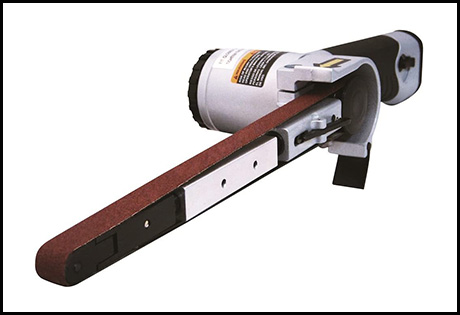
This is a specialty grinder with primarily metal grinding applications (although it can be used in wood projects as well). Powered by your shops pneumatic air supply, this blade sanding machine has a variable speed control that can spin the turbine up to 16,000 rpm. Average air consumption is 4 cubic feet per minute with a 90-psi supply, and that generates ½ horsepower of torque.
The most common use for a tool like this is for grinding down spot welds, and other metal grinding applications that require a bladed sander/grinder. The position of the sanding arm is adjustable, so you can angle it in any way to make it easier to reach welds in complicated areas on a machine.
Owners of the Astro 3037 give it an 8.8 out of 10 rating, but there are quite a few complaints about this tool shredding belt faster than other brands. The reason for that seems to be that the Astro has a hard wheel at the end of the arm, where other brands feature a wheel made of softer material. The slight cushioning effect of the soft wheel allow the belt to absorb vibrations and other forces without shredding.
Pros
- Adjustable arm
- Variable speed
Cons
- Shreds belts faster than other brands
- High noise level
Final Verdict
This is a specialty sander that isn’t going to find a home in many wood working shops. But in an auto body shop, or a metal fabrication facility an air grinder like this is an indispensable tool. But is this the right model to buy? Tough call. Many reviewers are happy with it, and it is clearly a quality tool. It has plenty of power and will stand up well under heavy use.
My concern is the reports about it shredding belts faster than other brands. The time lost to belt changes and the cost of belts themselves can add up. You can find machines that feature the cushioned nose wheel, but you are going to pay a lot more than the $87 I found this sander for.
So, it’s a balancing act between the high cost of another unit, or the cost of replacement belts for this one. As the saying goes, “You can pay me now or pay me later.”
Best Belt Sanders Buying Guide: What to Expect
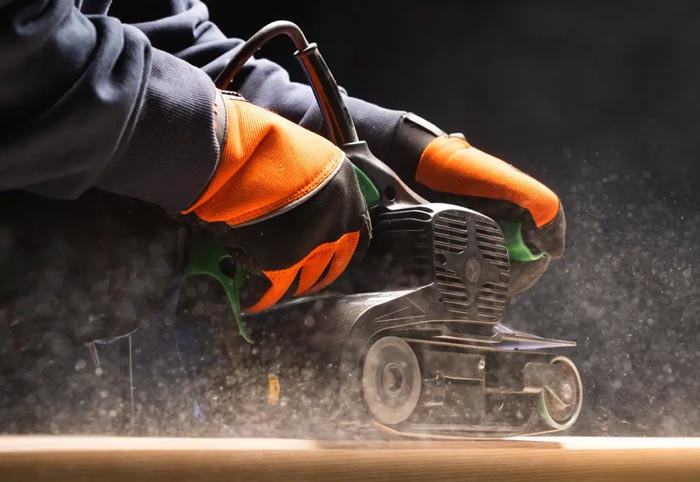
-
Top Factors to Look For
The first consideration I have when looking at belt sanders is the power rating of the motor. Powering a this tool is a tough job and if the motor isn’t up to it, you are going to find the machine bogging down on you. This leads to a less than satisfactory sanding job and it’s going to eat up a lot of time and effort on your part. Always pick a sander that has power to spare.
Design and durability are my number two considerations. A sander has to be sturdy enough to stand up to a rigorous assignment. Lightweight plastic parts, small screws, handles that may break are all red flags to me. One of the biggest design complaints about many models is the dust collection system. Many use cloth bags, and some use a plastic box of some sort. Neither is necessarily better, but make sure that whichever you choose, the attachment system is strong enough to withstand the rigors of the job. Broken dust collectors are a common complaint.
The weight and size of the machine matters. You want a bit of heft because the weight of the sander actually helps you maintain pressure on the surface you are sanding. If the tool is too light, you are going to have to put more of your body into the job, and the whole idea of using a machine for a task is to lessen your physical burden.
From this point, I start looking at the special features. Variable speed controls are one of the first things I look for. A machine that doesn’t offer variable rates has a big black mark against it. Flush edge sanding is another ability that a belt sander simply has to have. A decent warranty also provides a little peace of mind. I hope I never have to use the warranty, but I figure that if a company is willing to warranty their product, that tells me they believe they have built quality into that machine.
Lastly, I look at price. I don’t mind investing money in a woodworking tool that’s going to perform well for a long time. I would rather do that than have to buy a new one very year or so.
-
Pitfalls to Avoid
A belt sander has to have smooth running operation to be effective. If the machine is vibrating heavily or out of balance in some way, you’re not going to get great results. Heavy vibrations are also going to fatigue you as the operator. You simply won’t be able to use the sander for as long a period of time.
As I mention, there is simply no substitute for power. An underpowered working unit will bog down. So, you will have to lighten your pressure on the machine. The results? It’s going to take a lot longer to complete the task, and the results are likely not going to be as satisfactory. Always buy a model that has plenty of power to spare.
There is another problem with an underpowered belt sander. Running it at maximum capacity is going to lead to burning out that motor much faster than if it is just cruising along. Motor burnout is probably the number one reason that these tool owners find themselves looking for a new one.
To Whom Is This Product Beneficial?
If you do any work with wood, metal, or other building materials, you are going to need to sand pieces. It’s a mandatory part of any building or remodeling process. The larger your project, the more indispensable a belt sander becomes, and the more you are going to want to be sure you choose from among the highest performing machines for the task you face.
That doesn’t necessarily mean you have to buy the most expensive. If you have routine but small tasks, you might want to choose a cheap model. But if you plan to make a career out of refinishing hardwood floors, you are going to be in the market for heavy duty options to sand wood safely and properly.
If you’re like me, you will probably find yourself investing in more than one of the machines on our top ten belt sander list. As you will see, these machines offer a wide variety of features that make them useful for specific sanding niches.
About Belt Sanders
What is a Belt Sander?
In general, it is a machine with two rollers that a continuous belt of sandpaper spins between. The sandpaper is held in contact with the material being sanded by a pressure plate on the bottom of the unit. The larger that plate is, the greater surface area a sanding tool can work at any given moment. There are many variations to be found. One of the main differences between a belt sander and a drum sander is that drum sanders are stationary while the former one is portable.
What is a Belt Sander used for?
Belt sanders are typically woodworking tools, although there are some variations. They are used to remove old finishes for restoration of wood surface like floors and decks. This machine is really geared more towards completing larger tasks in as little time as possible. Yes, they can be fitted with fine grit sanding belts and do a great job of sanding large areas smooth. But, in truth, other sanding tools are more suited for the particular application.
How Are Belt Sanders Different from Other Types of Sanders?
These sanding tools are the true workhorses in the line-up of machines that grind away microscopic amounts of material in order to make a joint between two pieces or an entire surface smooth. Orbital, straight line, palm and sheet sanders, and all the variations thereof, really focus on finishes small areas to a very smooth and ultra-fine degree. These machines are more about working on larger surfaces, everything from a wood tabletop to an entire hardwood floor. Unlike an orbital sander, a belt sander does a great job for large surfaces.
Because they are called upon to work large areas, they are expected to be durable, powerful, and a bit on the heavy side. The heavier the machine, the less the operator has to put a shoulder into the job. Because of this, belt sanders can take a bit of muscle to use properly and, in fact, they also take a bit more practice than other types of sanders to develop a good touch for getting the job done right.
Belt Sanders Usage, Maintenance, and Safety Guide
How to Use Belt Sanders
Luckily for me, it takes more muscle than brain to operate a belt sander. It’s really very easy. Select the proper grit for the task at hand (remember the higher the number, the smoother the finish), slip the belt in place, latch the belt tensioner handle, and away you go.
A belt sander is really a constant tug-of-war. Unlike a drum sander, it wants to run away from you, and you need to rein it in place and keep it moving at a smooth, steady pace over the surface you are sanding. The smoother you can control it, the better the result. It does take a bit of practice, so start on a piece of scrap wood until you get the hang of keeping this dog on the leash.
Belt Sanders Safety Tips
The by-product of using a such machine is dust. Lots of dust. They all have some type of dust collecting system, but they are less than perfect. Protect yourself from this dust by wearing a mask, and eye protection. I prefer goggle-type eye protection, as opposed to safety glasses. The glasses won’t keep the dust out of your peepers. I also recommend leather gloves, because you don’t want bare skin coming in contact with a sanding belt that is running at a thousand feet per minute. Flesh loses that battle every time.
Belt Sanders Maintenance Tips

Once again, dust is your main concern. Keep the dust bag emptied. Thoroughly clean the dust from your belt sander after every use. An old paint brush is a great tool for this. Modern sanders have sealed bearings, so there really isn’t any lubrication required. On higher end models, you may be able to replace the drive belt after the machine has logged a zillion hours. Other than that, belt sanders don’t require much TLC.
It’s Time to Wrap Up
I have more than five decades of time in woodworking shops, and in that time, I have wrapped my hands around a lot more than one belt sander. This review is based on a lot of lessons learned the hard way, not just from me, but from the thousands of online reviewers who shared their experiences with us.
A lot of these machines specialize in one unique characteristic, and by studying not only what they can do, but what you really need them to do. Hopefully, following our in-depth review will help you find the belt sander you’re looking for.


